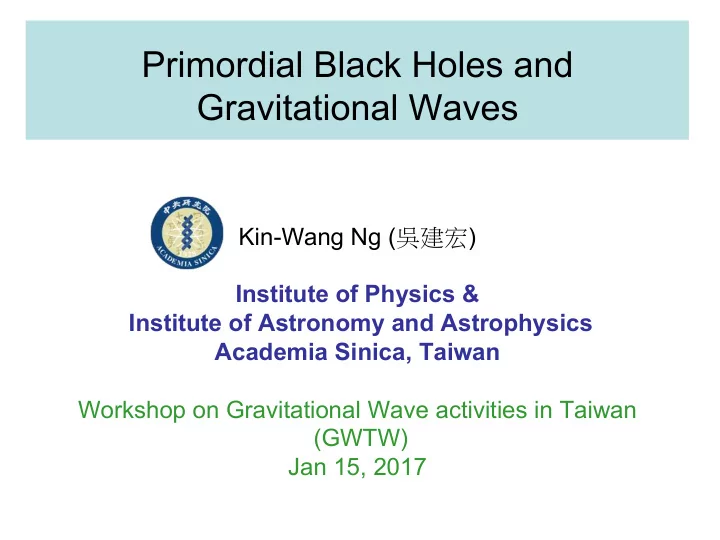

Primordial Black Holes and Gravitational Waves Kin-Wang Ng ( 吳建宏 ) Institute of Physics & Institute of Astronomy and Astrophysics Academia Sinica, Taiwan Workshop on Gravitational Wave activities in Taiwan (GWTW) Jan 15, 2017
Suyama
Versus astrophysical BHs from collapses of high-mass stars Zel'dovich & Novikov (1967), Hawking (1971) LIGO events are indirect signal of DM ! Suyama
Production of PBHs in inflation N is e-foldings before the end of inflation
e.g. Trapped inflation with a steep potential Cheng, Lee, Ng 16 inflaton-photon interaction φ E B à photon production - - - - m 2 φ 2 /2 all rescaled by M p
Production of 10-100M ¤ PBHs 2 = ( δρ / ρ ) 2 Density perturbation Δ ζ PBH bound - deduced from astrophysical and backreaction cosmological due to photon constraints on production PBH mass fraction β (M)
Associated Stochastic Gravitational waves Spectral energy density Pulsar timing array experiments Sources due to transverse traceless part T µ ν of higher-order density perturbation
GWs associated with PBHs of different masses in inflation models Inomata et al. 16 Garcia et al. 16 Cheng et al. 16
Conclusion • The binary BHs observed by aLIGO gravity-wave detectors may be primordial BHs • 10-100 M ¤ PBHs could be dark matter • Production of these PBHs in inflation models • Also can produce a wide range of PBH masses • How to distinguish PBHs from astrophysical BHs? PBHs have less spins – need more data and statistics • Associated stochastic gravitational waves polarized (+ mode / - mode) GWs in trapped inflation • Simulations on the evolution of PBHs G.-C. Luo, H. Tu binaries formation, merging rate, stochastic GW background
Recommend
More recommend